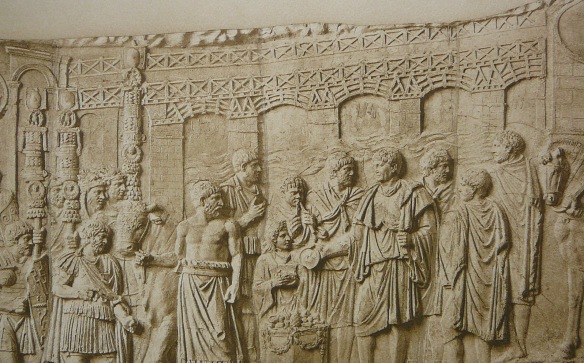The engineer, Apollodorus of Damascus, used wooden arches set on twenty masonry pillars (made with bricks, mortar and pozzolana cement) that spanned 52-meters each. However, the way it was built — in such a short time (103-105) — is still a mystery and it is thought that the course of the Danube may have been diverted during the construction.
The bridge was destroyed by Aurelian, after the Roman Empire withdrew its troops from Dacia. It was for more than a thousand years the longest bridge that had ever been built.
Cassius Dio writes a lengthy, reverent description of the bridge that Trajan built over the Danube, not far downstream from the Iron Gates. The description is all the more striking because the bridge no longer existed in his day; it was destroyed, as he writes in the same passage, by Hadrian. Its architect was the same Apollodorus who probably designed Trajan’s forum in Rome; it was probably the longest bridge ever constructed by the Romans:
Trajan built a stone bridge over the Ister, for which I cannot admire him enough there are other very magnificent works of his, but this is beyond them. For there are twenty piers of squared stone, and their height is one hundred fifty feet excluding the foundations, and their width is sixty feet; and these are one hundred seventy feet apart from each other, and they are linked together by arches. How could anyone fail to marvel (qaumavzein) at the expense made on them? (68.13.1-2)
Thus the difficulty of understanding the role of fiscal concerns in military decisions is only partly a result of the inadequacy of the ancient sources. These concerns seem to be inseparable from political and moral issues, questions of imperial image and posturing, and so forth. Clearly, to view Trajan’s Danube Bridge simply as a means of transporting troops and supplies across a river is to miss the point. Money was important, but what Trajan is buying here is not logistical support for his army but the awe and respect of his countrymen, and perhaps, from barbarians, terror.
We might wonder how he paid for it. It is possible that the money came out of the revenues from one of the only really lucrative military enterprises in the imperial period, the Dacian wars.
Located between the present day cities of Kladovo in Serbia, and Turnu Severin in Romania, the bridge crossed the 800m (2600 ft) wide Danube river with a total span of 1.1 km (3500 ft). With a total of 20 concrete piers, spaced approximately 50m (160 ft) apart, as the foundation, the wooden deck of the bridge was raised 45m (150 ft) above the river. The width of the bridge has been estimated to range from 10 to 15m (32 to 50 ft). The two outermost pillars are still visible on the banks of the river today.
During a record drop in the river level in 1856, all 20 pillars were visible for a brief time. Four pillars on the Romanian side were removed in 1906 to improve navigation of the river. The surviving 12 submerged pillars are the subject of an underwater study conducted currently by Gordana Karovic, chief archeologist for Serbia and Montenegro. Funding for this and other archeological studies was only recently restored, following a 15 year suspension during the time of Slobodan Milosovic.
The submerged pillars were formed using hydraulic cement, which cures underwater, and still show preserved traces of the large wooden beams, which supported the bridge deck.
The shape of the base of these pillars is pointed in the direction of water flow, which was designed to protect the bridge from debris carried by the river during flooding. This is a feature common on modern-day bridges.
The depth of the Danube at this crossing averages 8m (26 ft). In order for the construction of this bridge to have been completed in less than two years, it is thought that a large portion of the river’s flow must have been diverted. The current theory is that the river’s path was temporarily re-routed through a silted up arm of the river some distance upstream of the bridge. This method would have required the least amount of excavation.
There is still much uncertainty as to the fate of this bridge. Some speculate the bridge was ordered to be abandoned during the reign of Hadrian, who deliberately reduced the frontier of the empire. Others think the bridge was destroyed under orders from Aurelian, AD-270 to 275, to protect the empire from advancing barbarians, or collapsed due to natural causes. A joint investigation by archeologists from Serbia and Romania is being conducted with the goal of discovering when and how the bridge was destroyed.
